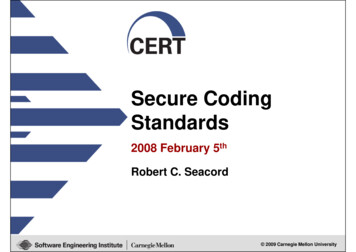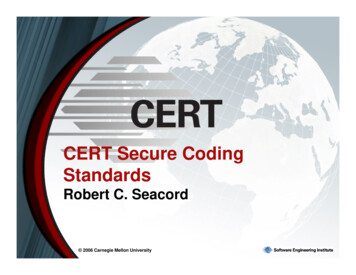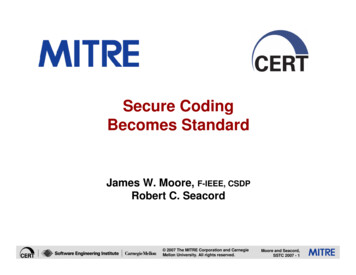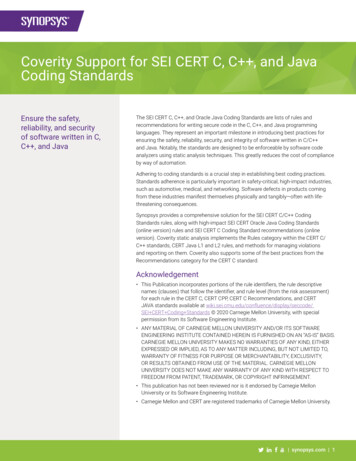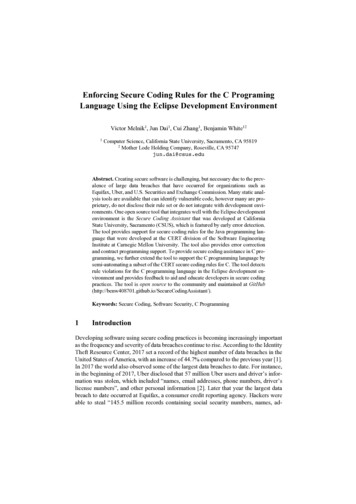
Transcription
Enforcing Secure Coding Rules for the C ProgramingLanguage Using the Eclipse Development EnvironmentVictor Melnik1, Jun Dai1, Cui Zhang1, Benjamin White121Computer Science, California State University, Sacramento, CA 958192Mother Lode Holding Company, Roseville, CA 95747jun.dai@csus.eduAbstract. Creating secure software is challenging, but necessary due to the prevalence of large data breaches that have occurred for organizations such asEquifax, Uber, and U.S. Securities and Exchange Commission. Many static analysis tools are available that can identify vulnerable code, however many are proprietary, do not disclose their rule set or do not integrate with development environments. One open source tool that integrates well with the Eclipse developmentenvironment is the Secure Coding Assistant that was developed at CaliforniaState University, Sacramento (CSUS), which is featured by early error detection.The tool provides support for secure coding rules for the Java programming language that were developed at the CERT division of the Software EngineeringInstitute at Carnegie Mellon University. The tool also provides error correctionand contract programming support. To provide secure coding assistance in C programming, we further extend the tool to support the C programming language bysemi-automating a subset of the CERT secure coding rules for C. The tool detectsrule violations for the C programming language in the Eclipse development environment and provides feedback to aid and educate developers in secure codingpractices. The tool is open source to the community and maintained at istant/).Keywords: Secure Coding, Software Security, C Programming1IntroductionDeveloping software using secure coding practices is becoming increasingly importantas the frequency and severity of data breaches continue to rise. According to the IdentityTheft Resource Center, 2017 set a record of the highest number of data breaches in theUnited States of America, with an increase of 44.7% compared to the previous year [1].In 2017 the world also observed some of the largest data breaches to date. For instance,in the beginning of 2017, Uber disclosed that 57 million Uber users and driver’s information was stolen, which included “names, email addresses, phone numbers, driver’slicense numbers”, and other personal information [2]. Later that year the largest databreach to date occurred at Equifax, a consumer credit reporting agency. Hackers wereable to steal “145.5 million records containing social security numbers, names, ad-
2dresses, credit card numbers and other personal information” [7]. Lastly, the U.S. Securities and Exchange Commission’s Electronic Data Gathering, Analysis, and Retrieval (EDGAR) system was infiltrated and information regarding mergers, acquisitions and other company data was exfiltrated [3]. The severity of this data breach isdifficult to assess, because the data retrieved could be used in the future to make millions to billions of dollars for criminal organizations. Many of these attacks could havebeen mitigated or prevented if the organizations enforced more stringent coding practices.There are many vulnerabilities that are reported and published on the Common Vulnerability Enumeration (CVE) website. It would take a good deal of effort to keep upwith ever newly published vulnerability. In 2017 alone, 14,712 CVEs were published[12]. This was an unprecedented spike in code vulnerabilities compared to 2016, whereonly 6,447 CVEs were published [12]. According to IEEE Senior Member GaryMcGraw, “there has been too much focus on common bugs and not enough on securedesign and avoidance of flaws” [13].To stay ahead of the curve of newly published vulnerabilities, various tools weredeveloped to provide code weakness detection and secure coding assistance. Our toolnamed Secure Coding Assistant is one of these efforts, which is open source and implements the CERT secure coding rules for Java programming language [7] [18-19]. Itis a static analysis tool that was developed in 2016 [18-19] and later enhance in 2017at [7]. The tool, featured by early detection, provides support for the CERT secure coding rules for the Java language. It also provides error correction and contract programming for the Java language. The rules were developed at the CERT division of theSoftware Engineering Institute at Carnegie Mellon University. By enforcing the rulesthroughout coding, newly developed software can avoid common security pitfalls.This paper is focused on the enhancement of the tool by semi-automating the securecoding rules for C programming language. To achieve this goal, a subset of the CERTsecure coding rules for C will be carefully selected and implemented. Specifically, thetool will flag unsecure code segments similar to problem markers generated during thecompilation process. These markers will provide the developer with the name of theviolated rule and information on how to remediate the vulnerable code. These problemmarkers will help educate software developers on secure coding principles.Throughout this paper, the enhancement to provide support for the C language to theSecure Coding Assistant will be referred to as the Secure Coding Assistant for C. SecureCoding Assistant for Java will be used to refer to the original software that was developed for the Java language. The Secure Coding Assistant for C and Secure CodingAssistant for Java are integrated as part of the same tool but are mutually exclusivecomponents within the tool, due to their inherent difference in programming language.2Related WorkThere are currently many static analysis tools that are available to aid developers inmaking secure software. Table 1 provides a list of some of these available tools. Thefirst five are commercial tools while the rest are open source ones.
3All the tools that are closed source do not disclose the rule set or the methodologiesthat are used to detect vulnerabilities in the developer’s source code. The first four opensource tools, scan source code for vulnerabilities but do not disclose which rule set thetool is based on. Also, two of these open source tools have not been updated for a fewyears. VisualCodeGrepper has not been updated in the past two years, while PreFasthas not been updated since 2005. The tool that is most closely related to our tool inFlawfinder. Flawfinder is an open source tool that is available for download on GitHub.Flawfinder is based on the Common Weaknesses Enumeration (CWE) database anddetects vulnerable code segments by matching code against a database of C/C functions with known problems. Unlike Flawfinder, Secure Coding Assistant is based onan established secure coding rule set and does not rely on new vulnerabilities to bepublished to update the tool. Secure Coding Assistant will be maintained and furtherdeveloped by the Department of Computer Science at CSUS.Table 1. Current Secure Code Analysis Tools.CompanyToolsRule SetSynopsysCoverity Static Analysis ToolProprietaryClosedVeracodeStatic Analysis SASTProprietaryClosedRouge Wave SoftwareKlocWorkProprietaryClosedViva64PVS-Studio AnalyzerProprietaryClosedMicro FocusFortify Static Code nNCC GroupVisual Code GrepperCustomOpenMichael ScovettaYascaCustomOpenDaniel MarjamäkiCPPCheckCustomOpenDavid There are two goals that are expected by enhancing the Secure Coding Assistant. Thefirst goal is to provide developers with feedback when compiling their source code.This will be similar to warnings and error problem reports that are generated during thecompilation process. This feedback will allow developers to mitigate security vulnerabilities during the development of their software.The second goal is to educate developers on secure coding practices for the C language. This goal will be accomplished by providing developers with problem alerts thatprovide a clear message that specifies the violated rule and guideline on how to remediate the unsecure code segment. These two implemented goals will create a learningenvironment that will educate software developers on the secure coding practices forthe C language.
43.2ArchitectureThe Secure Coding Assistant for C runs when the build command in Eclipse is called.The build command is used to compile all the C source code files within an open project. Eclipse refers to source code files that are inputted into a compiler as translationunits. As the build command runs, all the nodes in the translation unit are analyzed todetermine if any rules are violated. Fig. 1 shows the high-level flow on the overall design for the Secure Coding Assistant for C. When the build command is called all thepre-existing markers in the source code are cleared, and the first node within the firsttranslation unit is visited. If a rule is violated in the node, a marker is generated withthe name of the rule violated and its remediation information. Then the next node in thetranslation unit is visited. This process continues until all the nodes in the translationunit have been visited and analyzed. If there are more translation units in that need tobe compiled, the next translation unit is visited, and all its node are subsequently analyzed. Once all the translation units within the project are visited and analyzed, theSecure Coding Assistant for C displays all the markers that have been created duringthe build processes. The Secure Coding Assistant for C will run and display all theproblem markers in the project’s translation units, even if the build fails to compile theproject successfully.Fig. 1. Secure Coding Assistant for C High-level Flow Chart.4ImplementationThe idea to use the Eclipse Development Environment as the common platform decidesthat the Secure Coding Assistant for C and the Secure Coding Assistant for Java couldshare methodologies for implementation. The difference between the two analyzers ismainly that they utilize a different Eclipse tooling library. Specifically, the Secure Coding Assistant for C utilizes the Eclipse C/C Development Tooling (CDT) library,while the Secure Coding Assistant for Java utilizes the Eclipse Java Development Tooling (JDT) library.
54.1Rule SelectionThe CERT secure coding standard provides a total of 120 rules for C which are dividedinto 17 specific categories. To determine which rules are to be incorporated into theSecure Coding Assistant for C, the rules are first divided into two categories: rule thatcould be automated and rules that could not be automated. For a majority of the Csecure coding rules, the CERT website provides information on whether the rule canbe automated or not.An example of a rule that could not be automated is the FIO32-C rule, which statesto not perform file operations on devices that are only appropriate for files [15]. In theUNIX and Windows operating systems, special files are used to represent devices. Todetermine if this rule was violated, the tool would require a mechanism of identifyingeach file as it was inputted into a file operation function. Since this information couldonly be gathered during runtime, this rule could not be automated in a static analysistool.Additionally, the CERT secure coding standard for C contained three rule categoriesthat did not contain any rules that could be automated. One of these rule categories isthe Preprocessor category. The Preprocessor rule category could not be automated dueto the limitation of the Eclipse CDT library. The library did not provide a method toanalyze preprocessor code segments in a translation unit. This limitation prevented thetool from being able to automate any of the rules within this rule category.From the 120 CERT rules for C, 38 were determined to be automatable. From the38 rules that were determined to be automatable 20 rules were selected to be automatedin the tool. The 20 rules that were selected for this tool were determined based on theirseverity, and the likelihood that the rule violation would occur. The CERT website provided the classification for each rule. Additionally, rules were also selected to representall the 17 rule categories that did contain automatable rules.4.2Plugin ImplementationTo develop the Secure Coding Assistant for C, the Eclipse Plugin Development Environment (PDE) was utilized. The Eclipse PDE provides developers with extensionpoints that can be used to improve and customize the existing development environment. Extension points are a combination of XML mark-up language and a Java interface, that allow for one plugin to extend and customize the functionality of anotherplugin [4].The Secure Coding Assistant for C extends one extension point. The extension pointis org.eclipse.cdt.core.ErrorParser. This extension point allows the plugin to fulfil twofunctions. First, it allows the plugin to interact with the C build process. Build is usedto compile and link the source files in an open project. Second, it allows for the generation of problem markers. Problem markers are used to mark the segment of code thatcontains a rule violation and provide a tool-tip that contains information on the violatedrule and how to remediate the unsecure code.
64.3Abstract Syntax TreeEach translation unit in a C project is represented as an Abstract Syntax Tree (AST).An AST is a tree model that is used to represent the structure of a programming language’s source code file. An AST can be traversed depth-first from top to bottom orbottom to top.The Eclipse CDT library provides a mechanism to examine the AST through heAST,theorg.eclipse.cdt.core.dom.ast package provides the class ASTVisitor. ASTVisitor provides a visit() method for each of the different types of nodes (variable declaration,expression statement, function parameters, etc.). The visit() method allows for eachnode within a translation unit to be visited and examined.The Secure Coding Assistant for C has two classes that extend the ASTVisitor class:SecureCodingNodeVisitor C and ASTNodeProcessor. SecureCodingNodeVisitor Cclass is used to access the AST during the build process. ASTNodeProcessor class isused by the Utility C library to aid in the detection of rule violations.4.4Rule DetectionThe Secure Coding Assistant for C uses two Java classes to fulfil the task of detectingrule violations: ASTNodeProcessor C, and Utility C.ASTNodeProcessor C is at the heart of rule detection. ASTNodeProcessor Ctraverses the AST of a translation unit a second time and creates collections of variousnode types such as variable declarations, function definitions, assignment statements,etc. ASTNodeProcessor C also assigns a numerical value to each node to keep track ofthe order in which the nodes appear in the source code. These collections of nodesallowed for easy retrieval of nodes that were called before and after the node beingcurrently analyzed.Table 2. Utility C Library.UtilityMethodGet scope of nodeDetermine if inner node is contained withinouter nodeGet list of all variables in the same scope asthe nodeGet list of function call parameterGet list of function call parameters for de, me()getFunctionParameterVarNamePrintf()Utility C library is a collection of methods that are used by more than one rule. Sincemany of the CERT rules share common rule detection logic, Utility C library was usedto simplify the logic for each rule. This library created a list of methods that could beused by future developers to expand the tool. The list of methods in the Utility C, alongwith the purpose they serve is show in Table 2. The Utility C library was expanded
7during the development of the Secure Coding Assistant for C tool. A new method wasadded when more than one rule was determined to share similar rule detection logic.Using both the ASTNodeProcessor C class and the Utility C library simplified the rulelogic for each rule and allows for code reusability.4.5Rule InterfaceEach rule implements the SecureCodingRule C interface. The interface provides methods for detecting a rule violation and for provide feedback to the user of the tool. Table3 provides the methods contained in the SecureCodingRule C interface.Table 3. SecureCodingRule C Interface [18].Method SignatureDescriptionBoolean violated CDT(IASTNode)Checks to see if a rule has been violated for a nodeString getRuleText()The description of the violated ruleString getRuleName()The description of the violated ruleString getRuleID()The ID of the violated ruleString getRuleRecommendation()Suggestions to remediate the insecure nodeThe security level of the violated rule: HIGH,MEDIUM, LOWThe URL to the rule on the CERT websiteInt securityLevel()String getRuleURL()This interface is borrowed from the Secure Coding Assistant for Java developed by[18-19]. However, since both tools use different Eclipse development libraries, the SecureCodingRule C.violated() function is modified to accommodate the difference.The SecureCodingRule C.violated() method takes one parameter, i.e. the node thatis currently being processed by the SecureCodingNodeVisitor C. The node is analyzedby the method and returns true if the rule has been violated. This method made the coderequired for running each rule against all the nodes in a translation unit simple. Fig. 2displays the rule traversal logic used in SecureCodingNodeVisitor C.5Evaluation5.1Accuracy5.1.1 CERT ValidationThe CERT website provides a list of example code as well as the definitions for eachof the CERT rules. Each rule contains a pair of code samples: one with a rule violationand one with the rule violation remediated. Some of the rules contained more than onepair of code examples. To initially develop the Secure Coding Assistant for C, the toolfocused on detecting the rule violation in the unsecure code segments. It also made surethat any false positives were remediated during this process. Once the Secure CodingAssistant for C was able to detect all the rule violation in the CERT’s rule sample code,the rule logic was considered to be complete.
85.1.2 False PositiveFig. 2. Rule Detection Logic in SecureCodingNodeVisitor C.Fig. 3. ERR34-C rule violation from Juliet Test Suite for C/C detected by Secure Coding Assistant [11].The Juliet Test Suite for C/C developed by the NSA Center for Assured Softwarewas used to conduct a false positive study [11]. This test suite consists of 64,099 C/C source code files which are categorized under 118 different CWEs. Each source codefile contains an unsecure code example paired with a secure code correction. The authors of the files provide comments within each file to identify the code segments thatcontain weaknesses. Many of the weaknesses that were documented in the Juliet TestSuite for C/C were not detected by the Secure Coding Assistant for C because mostCWEs do not directly translate over to any CERT rules. For example, CERT does notinclude any rules for code weaknesses such as unchecked return values or unreachablecode segments.The Secure Coding Assistant for C generated 11,021 secure coding warning whichare shown in Table 4. Ten of the 20 rules that were implemented in the tool detectedrule violations. The top two rules that were detected are the ERR34-C and MEM31-Crules, which collectively account for 68% of all the rule violations. The ERR34-C rulestates to detect errors when converting strings to a number [5]. This rule detects ruleviolations when using string to integer conversion functions that lack error reportingmechanism such as atoi, atoll, and atoll [5]. Fig. 3 shows an example of a rule violationfor the ERR34-C rule with its accompanied problem alert window. The rule MEM31-Cstates that dynamically allocated memory should be freed once it is no longer neededby the program [16]. This rule was detected, since many CWEs are associated withmemory leakage and corrupt memory pointers.
9Table 4. Juliet Test Suite for C/C Results.Each rule detection in Table 4 was manually inspected to determine if the alert wasa true positive or false positive. Table 5 displays the false positives that were identified.False positives accounted for 25% of all of the rule detections. Only two rules weredetermined to have false positive detections: the INT33-C and the MSC30-C rules.The highest false positive result was attributed to the INT33-C rule. This rule statesthat “division and modular operations should not result in a divide-by-zero error” [14].These false positives stem from floating point division, where a conditional statementchecks to see if the divisor is greater than the value of .00001 before performing division. The rule logic in the tool is structured to check if the divisor is greater than zero,greater than or equal to one, or not equal zero. It would be difficult to account for thedifferent variations of conditional statements that can be satisfied to check if a floatingpoint number is not equal to zero. This makes avoiding false positives for this ruledifficult. This rule highlights that the rule detection logic for this rule should be revisited.The second highest false positive result is attributed to the MSC30-C rule. This rulestates to not use the function rand() to generate pseudorandom numbers for applicationthat have a strong pseudorandom number requirement [9]. The false positive resultsfound were in source files that were using rand() for purposes that did not need strongpseudorandom values. It would be difficult to fix the false positives that were generatedby this rule, because it requires context into how these random number will be used inan application. Future release of the Secure Coding Assistant for C could provide the
10option to hide a secure coding rule violation if there is disagreement with the tool. Thiswould help minimize the number of false positive detections.Table 5. False Positive Results.RuleTotalCountTrue Pos.CountTrue Pos.(%)False Pos.CountFalse .5762.1971.7249130779824.4337.8128.285.1.3 False NegativeTo conduct a false negative study on the Secure Coding Assistant for C, the Juliet TestSuite for C/C [11] and the CWE website database [10] were used. These sourceswere used because they contained code segments that provided documented vulnerabilities. The false negative study was done by looking through both sources and determining if the documented vulnerability should have been picked up by the tool. Thetool failed to detect rule violations for the FIO45-C and STR34-C rules.The false negative instance for the FIO45-C rule was found in the Juliet Test Suitefor C/C . The FIO45-C rule states that a TOCTOU (time-of-check, time-of-use) raceconditions should be avoided when more than one concurrent process is operating on ashared file system [17]. The code segment that should have been picked up by the toolis shown in Fig. 4. The Secure Coding Assistant for C did not flag this code segmentas a vulnerability because the #define preprocessor directive was used to rename thefile operations stat and open to STAT and OPEN, respectively.Fig. 4. Code segment from Juliet Test Suite for C/C [11].The false negative instance for the STR34-C rule was discovered on the CWE website under CWE-843: Access of Resource Using Incompatible Type [10]. CWE-843does not relate to the CERT rule STR34-C, however the CWE code example containeda segment of code that violated the STR34-C rule. The STR34-C rule states that charshould be cast to an unsigned char before converting the value to a larger integer size[6]. Fig. 5 displays the code segment from CWE-843 that should have been detected asa rule violation under the STR34-C rule. The character variable defaultMessage is castto the integer buf.nameID without first casting the char to an unsigned char. Customcode was written to identify the variable being accessed using the member access operator for variables declared within complex data structures such as union and struct.
11This code was written since the Eclipse CDT library lacked this mechanism. The logicfailed to consider a complex data structure being nested within another complex datastructure. This case was not considered because none of the CERT examples providedcode segments where this case occurred. This is a limitation of the tool that will beaddresses in future developments.Fig. 5. CWE-843 code segment from CWE website [10].5.2EfficiencyThe tool’s efficiency was measured by running the build command against test suitesfrom [11] and test files that were generate from the CERT website examples to initiallytest this tool. Each project was built 3 times with and without the tool enabled to gatherthe average build time. After each build, the clean command was called to delete all thegenerate binaries. The Secure Coding Assistant for C efficiency result are shown inTable 6. The second to last column in Table 6 shows the increase in time to build thebinaries for a project. The time it takes to build a project appears to be correlated withthe number of files in a project, as well as the number of detected violations. There isan average 4.45% increase in build time with the tool enabled.Table 6. Efficiency Test Results.ProjectCERTTest 45Test 46Test 101Test 106Files20666458247Alerts50131829113Time Increase (s)1.213.484.755.4214.71Increase (%)5.7415.8421.659.0412.44
126Limitations, Conclusion and Future WorkThe enhancement to the Secure Coding Assistant for C programming language hasproven to be pragmatic, efficient and accurate. The future developments will focus onimproving the efficiency of the tool by fine tuning the rule logic and by minimizing thefalse positive and false negative rates. There will also be a focus on adding additionalfeatures such as providing the user the ability to hide problem markers if they disagreewith the tool and by providing support for the C language. Additionally, the rest forthe CERT rules for C that were identified as automatable will be implemented.There are many static analysis tools that provide secure code analysis that are available for developers. However, none of these tools implement the CERT secure codingrules for the C programming language. This paper provides C programmers with aneducational development tool that enforce secure coding standards. This tool is opensource and will continue to be maintained by the Department of Computer Science atCSUS. The tool is available on the project website at istant/).This project was conducted when Victor Melnik was a student in MS Computer Science program at California State University, Sacramento. More implementation detailscan be found in his Master Project Report [20], that is an extended version of this paper.7AcknowledgementsAcknowledgements and attributions are given to Carnegie Mellon University and itsSoftware Engineering Institute, as this publication incorporates portions of the “SEICERT C Coding Standard” (c) 2017 Carnegie Mellon University, with special permission from its Software Engineering Institute”. Any material of Carnegie Mellon University and/or its software engineering institute contained herein is furnished on an “asis” basis. Carnegie Mellon University makes no warranties of any kind, either expressedor implied, as to any matter including, but not limited to, warranty of fitness for purposeor merchantability, exclusivity, or results obtained from use of the material, CarnegieMellon University does not make any warranty of any kind with respect to freedomfrom patent, trademark, or copyright infringement. This publication has not been reviewed nor is it endorsed by Carnegie Mellon University or its Software EngineeringInstitute. CERT and CERT Coordination Center are registered trademarks of CarnegieMellon University.References1. 2017 Annual Data Breach Year-End Review, 017Breaches/2017AnnualDataBreachYearEndReview.pdf. Retrieved on Feb 27, 2019.2. Bearak, S., 2017. Uber Data Breach Affects 57 Million: It is Time to Own Our to-own-our-identities. Retrieved on Feb 27, 2019.
133. Cimpanu, C., 2017. SEC Says Hackers Breached Its System, Might Have Stolen Data forInsider Trading. tolen-data-for-insider-trading/. Retrieved on Feb 27,2019.4. Eclipse., 2018. Extensions and Extension Points. http://help.eclipse.org/luna/index.jsp?topic .htm. Retrieved onFeb 27, 2019.5. Hicken, A., 2018. ERR34-C. Detect errors when converting a string to a number.https://wiki.sei.cmu.edu. Retrieved on Feb 27, 2019.6. Hicken, A., & Seacord, R., 2018. STR34-C. Cast characters to unsigned char before converting to larger integer sizes. https://wiki.sei.cmu.edu. Retrieved on Feb 27, 2019.7. Leary, J., 2018. Equifax Breach Impacts 147.9 Million: Steps to Keep Your Identity Protected. ntity-protected. Retrieved on Feb 27, 2019.8. Li, C., White, B., Dai, J., & Zhang, C., 2017. “Enhancing Secure Coding Assistant WithError Correction and Contract Programming”. Proceeding of National Cyber Summit 2017,Huntsville, AL, Jun 6-8, 2017.9. Long, F., & Hicken, A., 2018. MSC30-C. Do not use the rand() function for generatingpseudorandom numbers. https://wiki.sei.cmu.edu. Retrieved on Feb 27, 2019.10. MITRE, 2018. CWE-843: Access of Resource Using Incompatible Type ('Type Confusion').Common Weakness Enumeration.11. NIST, 2017. Test Suites, 4.9. NIST Samate: https://samate.nist.gov/SARD/testsuite.php. Retrieved on Feb 27, 2019.12. Ozk
The CERT secure coding standard provides a total of 120 rules for C which are divided into 17 specific categories. To determine which rules are to be incorporated into the Secure Coding Assistant for C, the rules are first divided into two categories: rule that could be automated and rules that could not be automated. For a majority of the C


